emergency towing VOLVO S80 2015 Owner´s Manual
[x] Cancel search | Manufacturer: VOLVO, Model Year: 2015, Model line: S80, Model: VOLVO S80 2015Pages: 392, PDF Size: 10.66 MB
Page 6 of 392
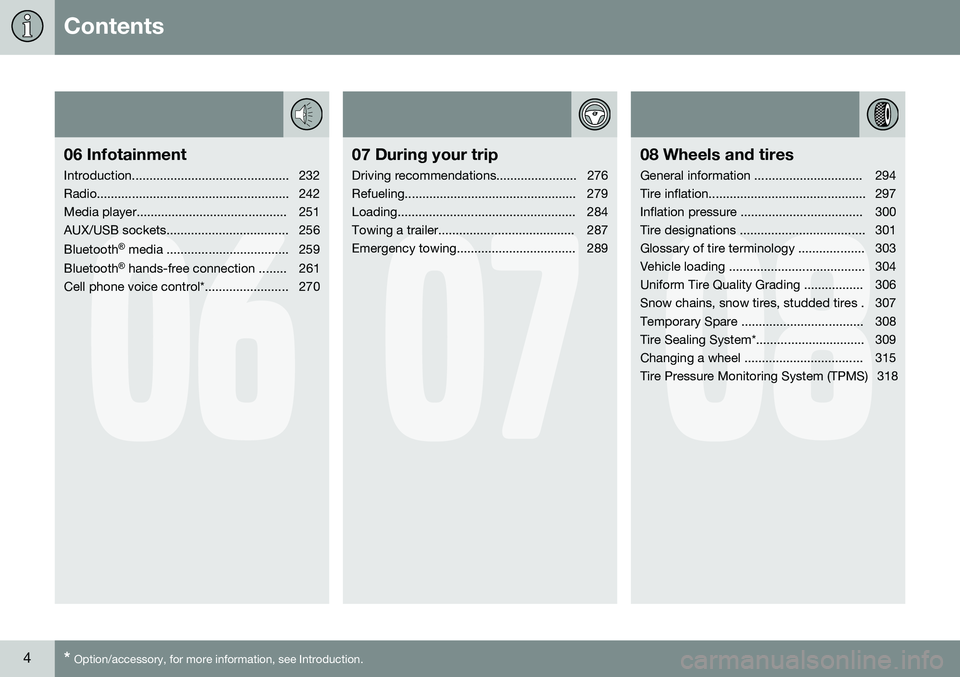
Contents
4* Option/accessory, for more information, see Introduction.
06
06 Infotainment
Introduction............................................. 232
Radio....................................................... 242
Media player........................................... 251
AUX/USB sockets................................... 256 Bluetooth ®
media ................................... 259
Bluetooth ®
hands-free connection ........ 261
Cell phone voice control*........................ 270
07
07 During your trip
Driving recommendations....................... 276
Refueling................................................. 279
Loading................................................... 284
Towing a trailer....................................... 287
Emergency towing.................................. 289
08
08 Wheels and tires
General information ............................... 294
Tire inflation............................................. 297
Inflation pressure ................................... 300
Tire designations .................................... 301
Glossary of tire terminology ................... 303
Vehicle loading ....................................... 304
Uniform Tire Quality Grading ................. 306
Snow chains, snow tires, studded tires . 307
Temporary Spare ................................... 308
Tire Sealing System*............................... 309
Changing a wheel .................................. 315
Tire Pressure Monitoring System (TPMS) 318
Page 87 of 392
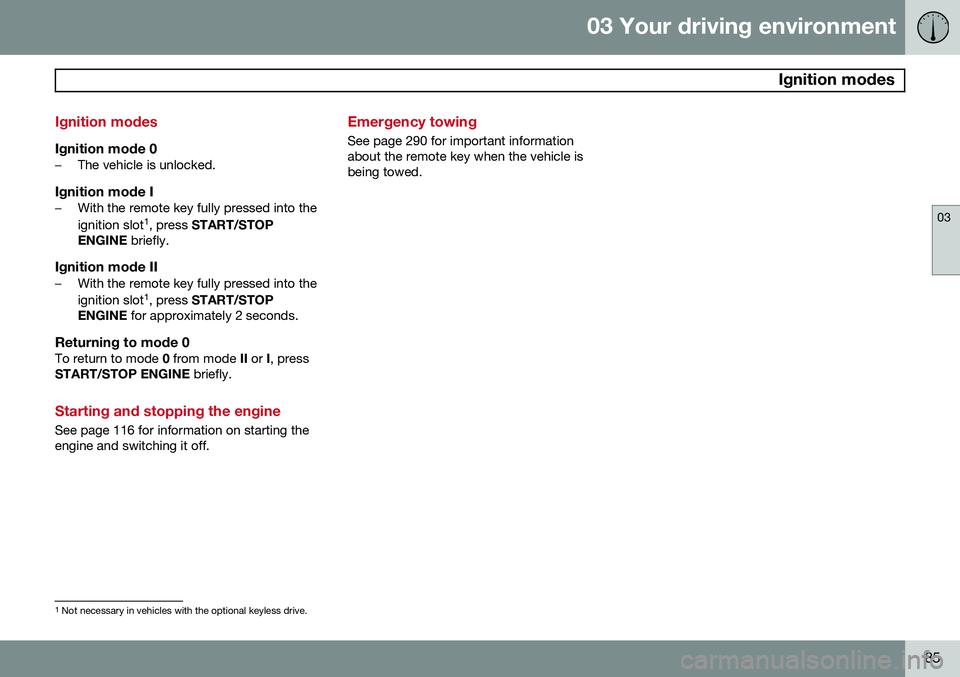
03 Your driving environment
Ignition modes
03
85
Ignition modes
Ignition mode 0–The vehicle is unlocked.
Ignition mode I–With the remote key fully pressed into the ignition slot1
, press START/STOP
ENGINE briefly.
Ignition mode II–With the remote key fully pressed into the ignition slot 1
, press START/STOP
ENGINE for approximately 2 seconds.
Returning to mode 0To return to mode 0 from mode II or I, press
START/STOP ENGINE briefly.
Starting and stopping the engine
See page 116 for information on starting the engine and switching it off.
Emergency towing
See page 290 for important information about the remote key when the vehicle isbeing towed.
1
Not necessary in vehicles with the optional keyless drive.
Page 138 of 392

03 Your driving environment
Brakes
03
136
The adaptive brake lights activate if: •The ABS system activates for more than approximately a half second
• In the event of sudden braking while thevehicle is moving at speeds aboveapproximately 6 mph (10 km/h)
When the vehicle has come to a stop, the brake lights and additional taillights remain onfor as long as the brake pedal is depressed oruntil braking force on the vehicle is reduced.
Power brakes function only when the engine is running
The power brakes utilize vacuum pressure which is only created when the engine is run-ning. Never let the vehicle roll to a stop withthe engine switched off. If the power brakes are not working, consid- erably higher pressure will be required on thebrake pedal to compensate for the lack ofpower assistance. This can happen for exam-ple when towing your vehicle or if the engineis switched off when the vehicle is rolling. Thebrake pedal feels harder than usual.
Water on brake discs and brake pads affects braking
Driving in rain and slush or passing throughan automatic car wash can cause water tocollect on the brake discs and pads. This willcause a delay in braking effect when the pedal is depressed. To avoid such a delaywhen the brakes are needed, depress thepedal occasionally when driving through rain,slush, etc. This will remove the water from thebrakes. Check that brake application feelsnormal. This should also be done after wash-ing or starting in very damp or cold weather.
Severe strain on the brake systemThe brakes will be subject to severe strainwhen driving in mountains or hilly areas, orwhen towing a trailer. Vehicle speed is usuallyslower, which means that the cooling of thebrakes is less efficient than when driving onlevel roads. To reduce the strain on thebrakes, shift into a lower gear and let theengine help with the braking. Do not forgetthat if you are towing a trailer, the brakes willbe subjected to a greater than normal load.
Anti-lock braking system (ABS)The Anti-lock Braking System (ABS) helps toimprove vehicle control (stopping and steer-ing) during severe braking conditions by limit-ing brake lockup. When the system "senses"impending lockup, braking pressure is auto-matically modulated in order to help preventlockup that could lead to a skid. The system performs a brief self-diagnostic test when the engine has been started anddriver releases the brake pedal. Another auto-matic test may be performed when the vehi-
cle first reaches a speed of approximately6 mph (10 km/h). The brake pedal will pulsateseveral times and a sound may be audiblefrom the ABS control module, which is nor-mal.
Cleaning the brake discsCoatings of dirt and water on the brake discsmay result in delayed brake function. Thisdelay is minimized by cleaning the brake lin-ings. Cleaning the brake pads is advisable in wet weather, prior to long-term parking, and afterthe vehicle has been washed. Do this bybraking gently for a short period while thevehicle is moving.
Emergency Brake AssistanceEBA is designed to provide full brake effectimmediately in the event of sudden, hardbraking. The system is activated by the speedwith which the brake pedal is depressed. When the EBA system is activated, the brake pedal will go down and pressure in the brakesystem immediately increases to the maxi-mum level. Maintain full pressure on thebrake pedal in order to utilize the systemcompletely. EBA is automatically deactivatedwhen the brake pedal is released.
Page 276 of 392
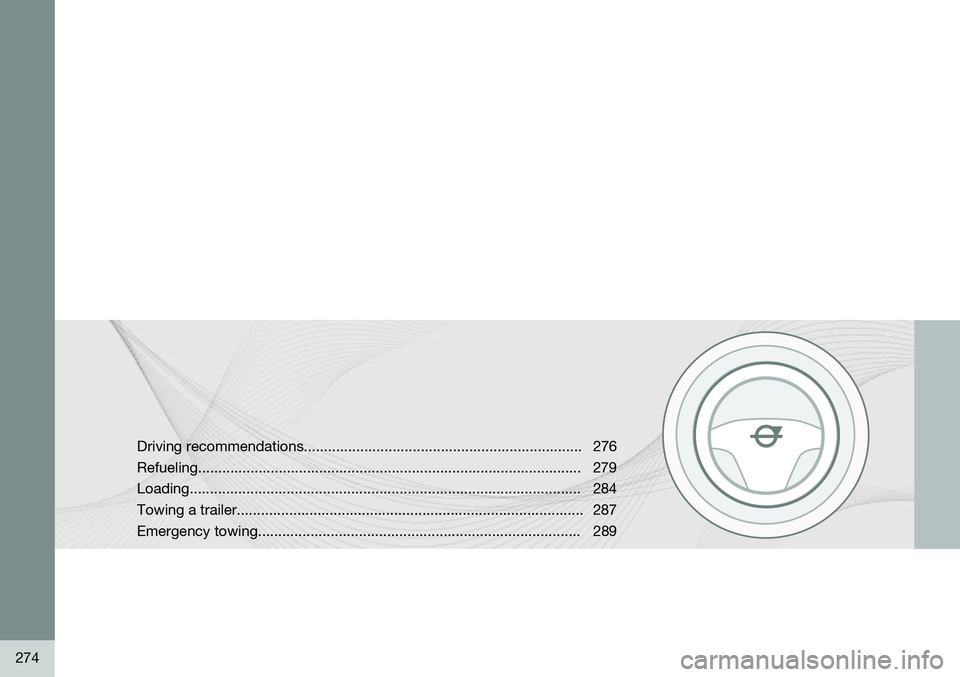
274
Driving recommendations..................................................................... 276 Refueling............................................................................................... 279Loading................................................................................................. 284Towing a trailer...................................................................................... 287
Emergency towing................................................................................ 289
Page 291 of 392
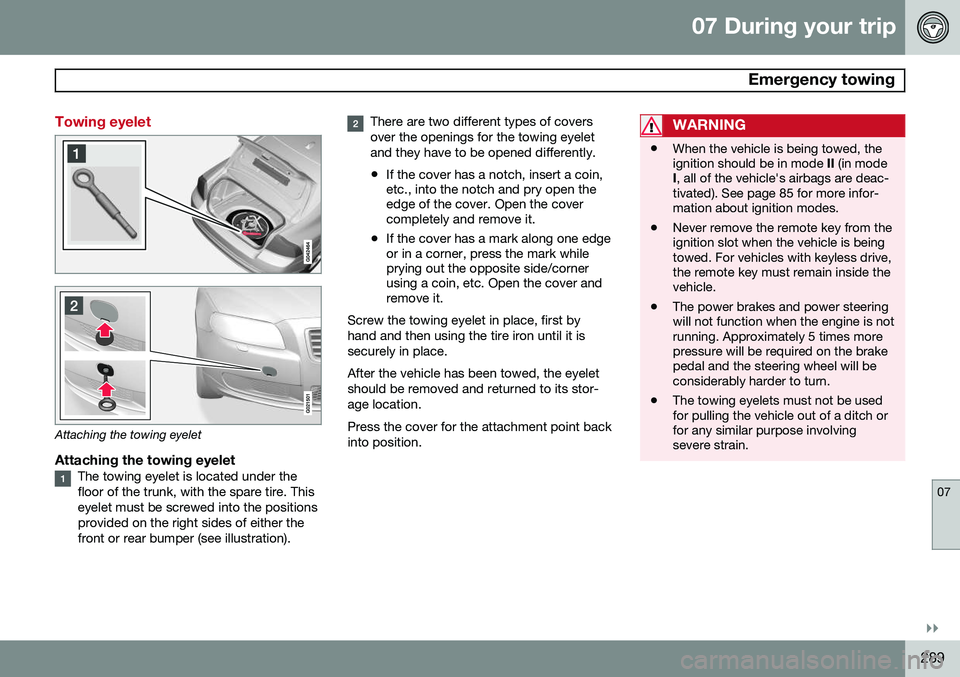
07 During your trip
Emergency towing
07
}}
289
Towing eyelet
Attaching the towing eyelet
Attaching the towing eyeletThe towing eyelet is located under the floor of the trunk, with the spare tire. Thiseyelet must be screwed into the positionsprovided on the right sides of either thefront or rear bumper (see illustration).
There are two different types of covers over the openings for the towing eyeletand they have to be opened differently.
• If the cover has a notch, insert a coin, etc., into the notch and pry open theedge of the cover. Open the covercompletely and remove it.
• If the cover has a mark along one edgeor in a corner, press the mark whileprying out the opposite side/cornerusing a coin, etc. Open the cover andremove it.
Screw the towing eyelet in place, first by hand and then using the tire iron until it issecurely in place. After the vehicle has been towed, the eyelet should be removed and returned to its stor-age location. Press the cover for the attachment point back into position.WARNING
• When the vehicle is being towed, the ignition should be in mode
II (in mode
I , all of the vehicle's airbags are deac-
tivated). See page 85 for more infor-mation about ignition modes.
• Never remove the remote key from theignition slot when the vehicle is beingtowed. For vehicles with keyless drive,the remote key must remain inside thevehicle.
• The power brakes and power steeringwill not function when the engine is notrunning. Approximately 5 times morepressure will be required on the brakepedal and the steering wheel will beconsiderably harder to turn.
• The towing eyelets must not be usedfor pulling the vehicle out of a ditch orfor any similar purpose involvingsevere strain.
Page 292 of 392

07 During your trip
Emergency towing
07
290* Option/accessory, for more information, see Introduction.
Having the vehicle towed by a tow truck
Call for professional help from an authorized towing company. Volvo recommends the useof flat bed equipment.
CAUTION
In certain conditions, the towing eyelet may be used to pull the vehicle onto aflatbed tow truck.
• The vehicle's position and ground clearance determine if it can be pulledup onto a flatbed tow truck using thetowing eyelet.
• If the angle of the tow truck’s ramp istoo steep or the ground clearanceunder the vehicle is insufficient, dam-age could occur by attempting to pullthe vehicle using the towing eyelet.
• If necessary, lift the vehicle using thetow truck’s lifting device.
WARNING
No person or object should be behind the tow truck while the vehicle is being pulledup onto the flatbed.
CAUTION
•The vehicle should always be towed in the forward direction.
• Vehicles with All Wheel Drive (AWD)*that are being towed with the frontwheels off the ground should not betowed at a speed above approx.45 mph (70 km/h) and should not betowed farther than 30 miles (50 km).
Towing the vehicle
1. With the remote key fully pressed into the
ignition slot 1
, press START/STOP
ENGINE for approximately 2 seconds to
activate ignition mode II.
2. The remote key must remain in the igni- tion slot 2
for the entire time that the vehi-
cle is being towed.
3. Keep the tow rope taut when the towing vehicle slows down by applying light pressure on the brake pedal. This willhelp prevent jarring movements of thevehicle being towed.
4. Be prepared to apply the brakes to stop the vehicle being towed.
CAUTION
General towing precautions:
• Please check with state and local authorities before attempting this typeof towing, as vehicles being towed aresubject to regulations regarding maxi-mum towing speed, length and type oftowing device, lighting, etc.
• If the vehicle's battery is dead, seepage 119 to provide current for releas-ing the electric parking brake and tomove the gear selector from the
P
position to N. If this is not possible,
see page 124 for information aboutmanually overriding the shiftlock sys-tem to move the gear selector from P
to N.
• Maximum speed: 50 mph (80 km/h).Do not exceed the maximum allowabletowing speed.
• Maximum distance with front wheelson ground: 50 miles (80 km).
• The vehicle should only be towed inthe forward direction.
1
Not necessary in vehicles with the optional keyless drive.
2 For vehicles with the optional keyless drive, the remote key must be in the vehicle.
Page 384 of 392
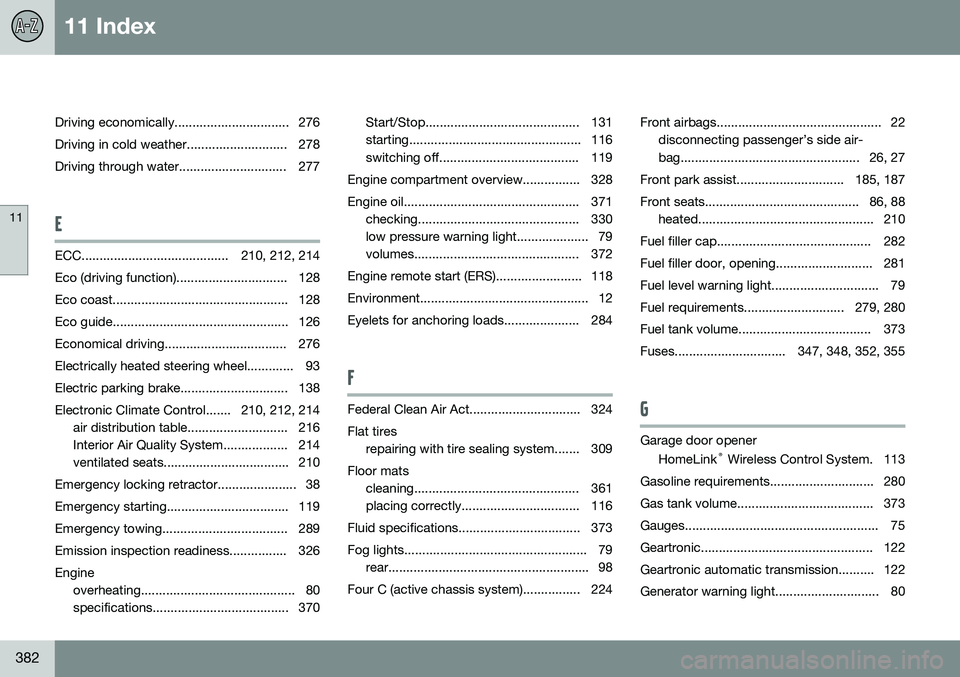
11 Index
11
382
Driving economically................................ 276
Driving in cold weather............................ 278
Driving through water.............................. 277
E
ECC......................................... 210, 212, 214
Eco (driving function)............................... 128
Eco coast................................................. 128
Eco guide................................................. 126
Economical driving.................................. 276
Electrically heated steering wheel............. 93
Electric parking brake.............................. 138
Electronic Climate Control....... 210, 212, 214air distribution table............................ 216
Interior Air Quality System.................. 214
ventilated seats................................... 210
Emergency locking retractor...................... 38
Emergency starting.................................. 119
Emergency towing................................... 289
Emission inspection readiness................ 326Engine overheating........................................... 80
specifications...................................... 370 Start/Stop........................................... 131
starting................................................ 116
switching off....................................... 119
Engine compartment overview................ 328
Engine oil................................................. 371 checking............................................. 330
low pressure warning light.................... 79
volumes.............................................. 372
Engine remote start (ERS)........................ 118
Environment............................................... 12
Eyelets for anchoring loads..................... 284
F
Federal Clean Air Act............................... 324 Flat tires repairing with tire sealing system....... 309
Floor mats cleaning.............................................. 361
placing correctly................................. 116
Fluid specifications.................................. 373
Fog lights................................................... 79 rear........................................................ 98
Four C (active chassis system)................ 224 Front airbags.............................................. 22
disconnecting passenger’s side air-
bag.................................................. 26, 27
Front park assist.............................. 185, 187
Front seats........................................... 86, 88 heated................................................. 210
Fuel filler cap........................................... 282
Fuel filler door, opening........................... 281
Fuel level warning light.............................. 79
Fuel requirements............................ 279, 280
Fuel tank volume..................................... 373
Fuses............................... 347, 348, 352, 355G
Garage door opener HomeLink ®
Wireless Control System. 113
Gasoline requirements............................. 280
Gas tank volume...................................... 373
Gauges...................................................... 75
Geartronic................................................ 122
Geartronic automatic transmission.......... 122
Generator warning light............................. 80